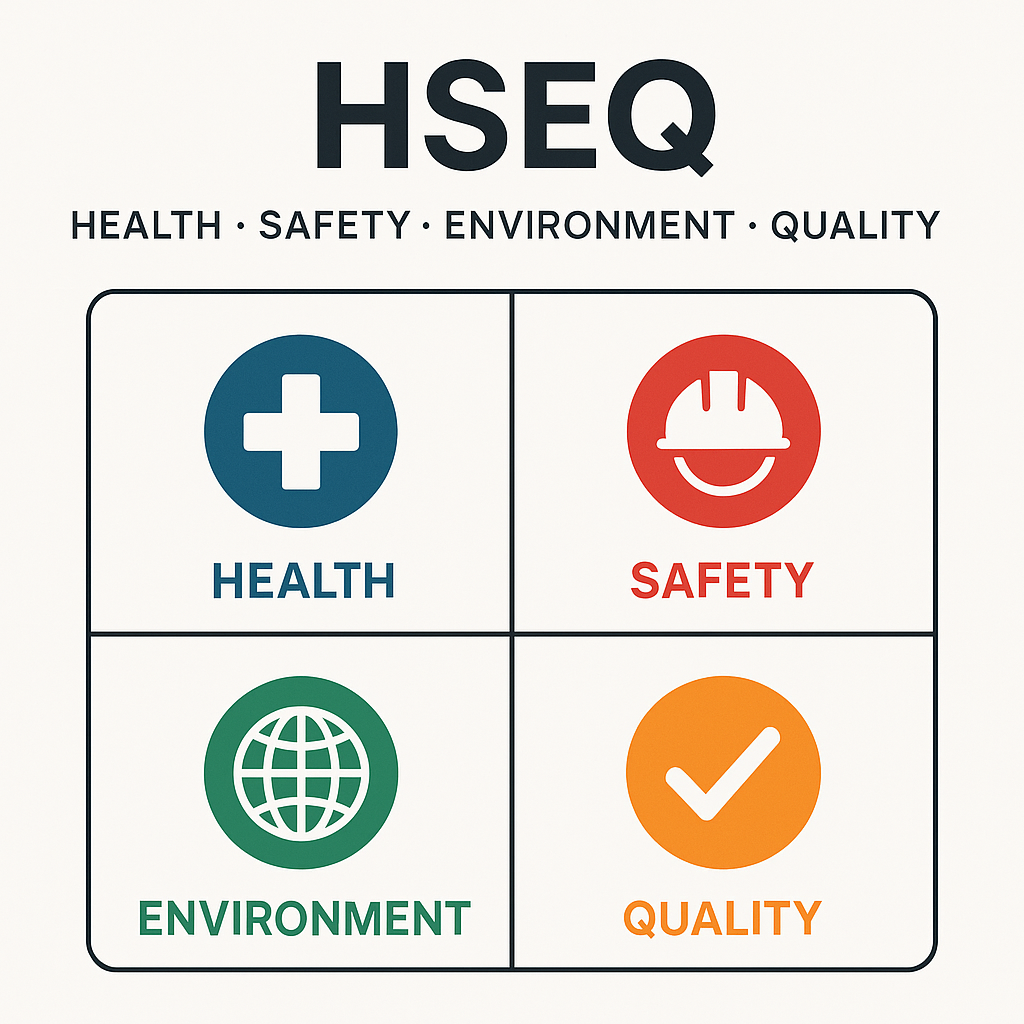HSEQ (Health, Safety, Environment, and Quality) is more than just an acronym—it’s a comprehensive framework that defines how organizations operate responsibly, safeguard their people, and ensure top-tier quality in their services and products.

At the core of a resilient, ethical, and sustainable workplace lies a strong commitment to HSEQ.
✅ What is HSEQ?
HSEQ stands for Health, Safety, Environment, and Quality—four critical pillars that organizations must integrate into their operations to ensure long-term success and regulatory compliance. Each component plays a unique role:
- Health ensures that employees’ physical and mental well-being are prioritized.
- Safety focuses on preventing injuries, incidents, and workplace hazards.
- Environment covers sustainable practices and reduction of ecological impacts.
- Quality ensures consistent delivery of products or services that meet defined standards.
Together, these pillars form a unified system that not only protects people and the planet but also enhances efficiency and customer satisfaction.

💡 Why HSEQ Matters in Today’s Workplace
HSEQ is no longer optional. In a global business landscape increasingly focused on sustainability and accountability, organizations with strong HSEQ systems gain:
- Regulatory Compliance: Meeting legal and industry standards.
- Risk Reduction: Proactively preventing accidents and liabilities.
- Reputation Management: Building trust with clients, partners, and the public.
- Operational Excellence: Improving productivity through safe and efficient practices.
Companies that embed HSEQ into their culture often outperform competitors in the long term.
Learn more about ISO standards for HSEQ (Dofollow)
🧠 Components of a Strong HSEQ Program
Health: Safeguarding Worker Well-being
A healthy workforce is a productive one. Organizations must prioritize:
- Regular health screenings
- Mental health support programs
- Ergonomic workstation assessments
- Vaccination and wellness initiatives
Safety: Preventing Workplace Injuries
Safety management is about anticipation and prevention. Core safety measures include:
- Job hazard analysis
- PPE compliance and training
- Emergency response plans
- Near-miss and incident reporting systems
Explore practical guidance on PPE use in various sectors in our PPE guidelines article.
Environment: Reducing Ecological Impact
Environmental responsibility is vital. Strategies include:
- Proper waste segregation and recycling
- Spill prevention and containment
- Emissions monitoring
- Sustainable resource usage
Check out OHSE.ca for Canadian resources on environmental safety (Dofollow).
Quality: Ensuring Excellence and Consistency
Without quality, safety and sustainability efforts fall short. Focus areas include:
- Quality assurance and control processes
- ISO 9001 implementation
- Continuous improvement methodologies
- Root cause analysis for failures
🛠 Implementing an HSEQ Management System
Implementing a robust HSEQ Management System (HSE-QMS) involves:
| Step | Description |
|---|---|
| 1. Leadership Commitment | Top management must drive the culture. |
| 2. Risk Assessment | Identify health, safety, and environmental risks. |
| 3. Training and Awareness | Ensure employees understand policies and procedures. |
| 4. Monitoring and Auditing | Track performance using KPIs and regular audits. |
| 5. Continuous Improvement | Use feedback and incident data to improve processes. |
📊 Measuring HSEQ Performance
Tracking your HSEQ system’s success involves both leading and lagging indicators:
- Leading: Training hours, safety observations, near-miss reports
- Lagging: Incident rates, lost time injuries, product rework percentages
Using digital dashboards or platforms like Intelex or Cority can automate and improve HSEQ data collection and reporting.
🔄 HSEQ Integration Across All Levels
For HSEQ to be effective, it must be everyone’s responsibility. This means:
- Employees follow procedures and report hazards
- Supervisors monitor performance and mentor staff
- Executives provide vision and resources
Empowering every worker to act as an HSEQ champion fosters a culture of ownership and continuous improvement.
🌍 Future of HSEQ: Embracing Technology and Sustainability
Modern HSEQ systems are evolving with technology. Innovations include:
- Wearable safety tech to monitor worker health
- AI-powered incident analytics
- Mobile inspection apps
- Green technology adoption to support carbon neutrality
The future of HSEQ lies in digital integration, proactive prevention, and alignment with ESG (Environmental, Social, Governance) goals.
📌 Internal HSEQ Tools and Documents to Use
- HSEQ Policy Statements
- Risk Registers
- Job Safety Analysis (JSA)
- Incident/Near-Miss Report Forms
- Corrective and Preventive Action Logs
- Quality Inspection Checklists
Access a customizable HSEQ fill form here (Internal link) to start evaluating your workplace.
✍️ Conclusion: HSEQ for a Safer, Smarter Workplace
HSEQ is the backbone of modern, ethical, and high-performing organizations. Prioritizing Health, Safety, Environment, and Quality not only ensures compliance but drives operational excellence, brand reputation, and long-term resilience.
Organizations that build a strong HSEQ culture don’t just protect—they thrive.
Leave a Reply